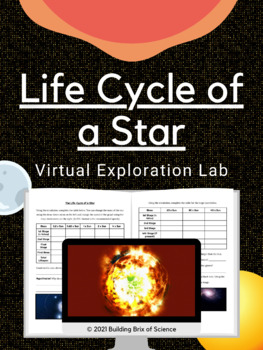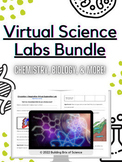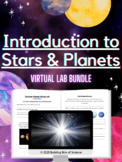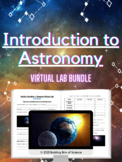Life Cycle of a Star Virtual Exploration Lab
- Zip
- Internet Activities
Also included in
- Save 30% on my store's entire virtual lab collection with this Science Virtual Exploration Labs Activity Bundle! These Virtual Labs cover a wide range of topics, including Chemistry, Astronomy, Genetics, and more! If you would like to try a free sample, please download Into the Bloodstream from my sPrice $157.50Original Price $225.00Save $67.50
- Get 30% off each lab with the Introduction to Stars & Planets Virtual Lab Bundle! These three interactive lab assignments will introduce your students to the Inner and Outer Planets of the Solar System and the Life Cycles of Stars. Students will learn:The Inner Planets⚗️Test their Pre-Existing KnPrice $6.25Original Price $9.00Save $2.75
- Get 30% off each lab with the Introduction to Astronomy Virtual Lab Bundle! These six interactive lab assignments will help your students explore the Planets & Stars of our Solar System and the Earth-Sun-Moon system. Students will learn:The Inner Planets⚗️Test their Pre-Existing Knowledge of thePrice $12.50Original Price $18.00Save $5.50
- Get over 30% off each assignment with the Introduction to Earth Science Virtual Lab Bundle! These Virtual Labs cover a wide range of topics, including Earth's Systems, Stars, & the Solar System! Included in this Virtual Lab Bundle are:AstronomyThe Inner PlanetsThe Outer PlanetsLife Cycle of a StPrice $35.50Original Price $51.00Save $15.50
Description
What are the stages of a star's life? In this virtual lab, students will use mathematical data to analyze the life cycles of different stars based on their initial mass. Students will also:
⚗️Test their Pre-Existing Knowledge of Stars
⚗️Analyze the Fusion of Hydrogen Atoms into Helium
⚗️Explain the Correlation between a Star's Mass and its' Age
⚗️Investigate the Formation of Neutron Stars & Black Holes
NOTE: This activity links to the Star in the Box Simulation from Las Cumbres University. Check it out below!
Star in a Box
Purchase includes the 3-page Student Worksheet (PDF), 3-page Teacher Answer Key (PDF), and 3-page Digital Student Worksheet (Google).
VIRTUAL LEARNING
This lab comes with a Google Slides version of the Student Worksheet hyperlinked in the Teacher Answer Key - this lab is designed for digital and face-to-face learning!
❗Permission is granted to copy pages specifically for student or teacher use only by the original purchaser or licensee. The reproduction of this product for any other use is strictly prohibited. Copying this product in any part and placing it on the Internet (even on a personal website) is strictly prohibited and a violation of the Digital Millennium Copyright Act (DCMA).
_________________________________________________________________
⭐ BE THE FIRST TO LEARN ABOUT NEW SCIENCE RESOURCES! ⭐
Hit the Green Star at the top of the page to follow my store! This will allow you to receive notifications whenever I update current resources and add brand new items.






